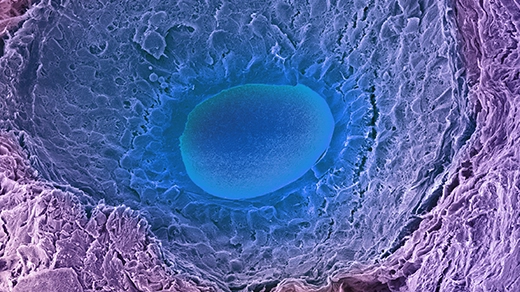Having lots of mitochondria is normally risky for cells because their chemical activity generates toxic byproducts known as free radicals. But when Böke peered inside dormant human and frog oocytes, they weren’t overloaded with free radicals at all. As she reported in a Nature paper published in 2022, the oocytes’ mitochondria were doing something surprising: They were skipping the step in their energy-generating process that produces these dangerous molecules. This meant that they produced less energy overall; Böke speculated that they direct all the energy they do produce for growth. No other cell had been observed to do this.
“Oocytes are crazy,” said David Pépin, associate director of the pediatric surgical research labs at Massachusetts General Hospital. “They have more mitochondria than any other cell, and those mitochondria are weird.”
The perils for long-lived cells go beyond free radicals. Scientists have seen how energy production and growth generate many proteins, including clumps of misfolded and damaged ones. To clear this harmful detritus, neurons, which like oocytes are long-lasting cells that don’t divide, rely on biochemical pathways that refold and degrade bungled proteins. When this machinery fails, protein aggregates can devastate entire neural networks, snuffing out communication and leading to neurodegenerative diseases like Alzheimer’s, Parkinson’s, Huntington’s and ALS.
After Böke published her 2022 research on free radicals, she wondered how oocytes tamp down problematic proteins. She dug through thousands of papers but couldn’t find any studies characterizing how oocytes cope. So, she looked to mouse oocytes to find the answer.
Because oocytes expand so massively and produce proteins so intensively during their growth period, Böke expected to see high protein activity in the two major pathways responsible for clearing aggregates. Instead, she saw less activity in immature oocytes than in mature egg cells.
“It doesn’t make much sense,” she said. “Why would you put your degradative activity down if you’re going to grow and make lots of things?”
It was because the oocytes weren’t degrading the damaging proteins — they were storing them to destroy later.
When Böke and her team infused oocytes with a dye that illuminates protein aggregates, she saw the proteins clustered in large compartments. Probing further, she used electron microscopy to reveal these distinct storage units as super-organelles, which she named ELVAs, or endolysosomal vesicular assemblies. These pouchlike objects are composed of lysosomes — the cell’s waste-disposal organelles — and other protein-degrading machinery.
In young oocytes, they are situated throughout the cytoplasm. Later, as oocytes mature, ELVAs fuse together, relocate and ramp up their degradative machinery. By the time an oocyte is fully mature, harmful protein aggregates are undetectable, and the ELVAs vanish, revealing a clean cytoplasm.
It’s possible that other long-lived, nondividing cells have similar machinery that uses this catch-and-release strategy for disposing of cellular waste. For example, researchers have found that some long-lived stem cells also have ELVA-like components, which capture and store aggregates until the cells are ready to divide. Neurons, too, can develop triage centers, called aggresomes, for organizing misfolded proteins. However, neurons destroy their cellular detritus throughout their life spans, while oocytes store them and then wipe them out all at once. Böke speculated that the oocytes’ method is more energy-efficient: Since their mitochondria produce less energy overall, they need all of it for necessary growth to reach reproductive maturity.
Böke’s findings offer new details and a fresh perspective on the biology of oocytes. They also suggest new approaches to fertility research. Clinical research has shown that older people are less likely to get pregnant than younger ones. The standard explanation is that their eggs may be “too old” for pregnancy. But what if an old egg is simply one that has accumulated too many misfolded proteins?
Böke’s lab is currently collaborating with fertility clinics to look at protein aggregates in human oocytes. She suspects that elements related to oocyte growth and quality control, such as mitochondria and protein aggregation, may account for some unexplained infertility cases. “A broken system gives errors in many different ways,” she said. The key to identifying those errors, and addressing them, will likely come from research, like Böke’s, that seeks to understand fundamentally how oocytes work.
>>> Read full article>>>
Copyright for syndicated content belongs to the linked Source : Quanta Magazine – https://www.quantamagazine.org/how-idle-egg-cells-defend-their-dna-from-damage-20240513/










